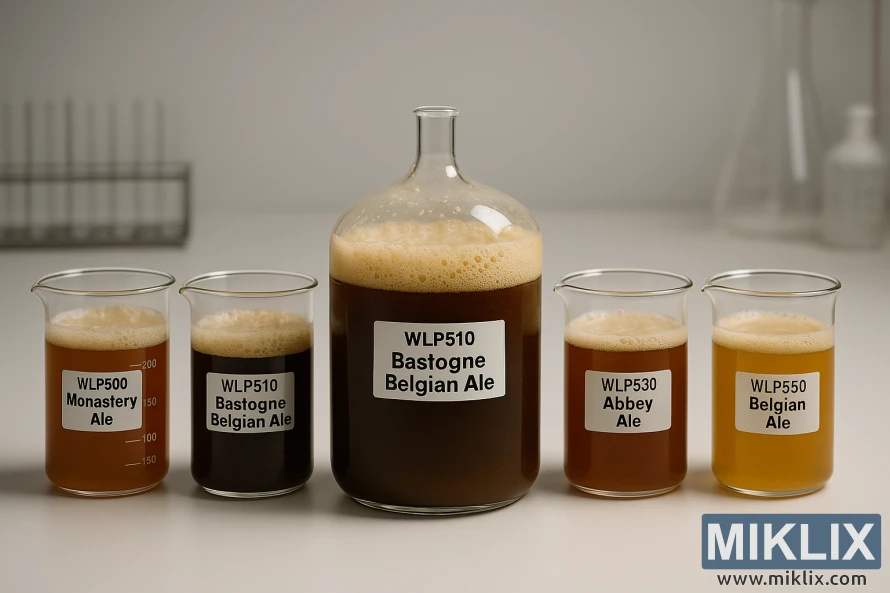Image: Belgian Ale Yeast Strain Comparison
Published: September 27, 2025 at 9:48:51 PM UTC
A lab still life of five fermenting Belgian ales showcasing White Labs yeast strains, highlighting differences in color, krausen, and fermentation activity.
The photograph depicts a carefully staged scientific comparison of White Labs Belgian ale yeast strains, presented with clarity and precision in a laboratory setting. The composition is landscape-oriented, with five distinct glass beakers neatly arranged in the foreground, each containing fermenting beer inoculated with a different yeast strain. The organization of the vessels, along with the clean minimalist background, evokes a professional and analytical tone, reinforcing the image’s role as an educational tool.
At the center of the arrangement, the largest and most prominent vessel is labeled WLP510 Bastogne Belgian Ale. This carboy-sized container dominates the scene and serves as the visual anchor, highlighting the strain’s importance in the comparative study. The Bastogne sample is a deep, opaque brown with subtle reddish undertones, capped by a generous layer of foamy krausen. The froth exhibits a creamy texture, dotted with bubbles of varying sizes, and seems to rise above the liquid in thick, uneven patches. The robust coloration and active surface activity communicate vitality and suggest a vigorous fermentation process.
Flanking the Bastogne vessel on either side are two smaller beakers, each distinctly labeled and filled with different beer samples. To the left, a beaker marked WLP500 Monastery Ale contains a liquid of coppery amber hue. Its foam is lighter, thinner, and less pronounced, reflecting both the yeast’s fermentation characteristics and the stage of activity captured in this moment. Next to it, the smaller WLP510 Bastogne Belgian Ale beaker mirrors the central vessel’s darker tones but in a smaller scale, reinforcing the theme of comparison and consistency across test volumes.
On the right side, the beaker labeled WLP530 Abbey Ale contains a reddish-brown beer, slightly lighter in color than the Bastogne but with more depth than the Monastery strain. Its foam is moderate, suggesting steady fermentation activity without the exuberance of the Bastogne. Beside it, the final beaker labeled WLP550 Belgian Ale stands out with its golden-amber color, notably lighter and brighter than the others. Its krausen is delicate, forming a thin ring of bubbles near the surface rather than a heavy cap. This visual contrast immediately conveys the diversity of yeast strains and their influence on beer appearance and fermentation character.
The laboratory background is understated yet purposeful. Clean white surfaces dominate the frame, with blurred outlines of scientific glassware and equipment visible in the periphery. A test tube rack appears on the far left, faint and out of focus, while additional flasks and containers sit to the right, their presence reinforcing the professional, research-oriented atmosphere. The minimalist environment removes distractions, ensuring the viewer’s attention remains fixed on the comparative study of yeast strains.
Lighting plays a crucial role in the composition. Soft, indirect illumination bathes the beakers and carboy, casting subtle shadows across the smooth laboratory bench. The light enhances the hues of the fermenting beer, revealing fine gradations of amber, brown, and gold, while also highlighting the foam textures that differ from strain to strain. Gentle reflections glint off the glass surfaces, adding depth and dimension without overpowering the clarity of the samples. The lighting also communicates a sense of sterility and control, in line with the academic tone of the image.
The overall mood of the photograph balances scientific rigor with aesthetic appeal. It is more than a snapshot of laboratory work; it is a carefully orchestrated visual narrative about yeast diversity and the impact of strain selection on brewing outcomes. By placing the Bastogne Belgian Ale at the center, the composition emphasizes focus while simultaneously inviting comparison across the spectrum of related strains. Each vessel tells a story—about fermentation vigor, flocculation behavior, attenuation, and the artistry of brewing interpreted through the lens of scientific inquiry.
This image is not merely educational but evocative: it underscores brewing as both science and craft. It bridges the gap between laboratory precision and the sensory world of beer, providing a visual demonstration of how yeast transforms wort into ale. For researchers, brewers, and enthusiasts alike, the photograph encapsulates the interplay of experimentation, observation, and tradition that defines the study of Belgian ale yeasts.
The image is related to: Fermenting Beer with White Labs WLP510 Bastogne Belgian Ale Yeast

